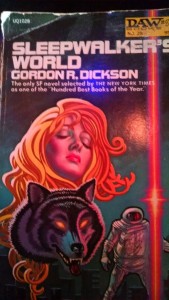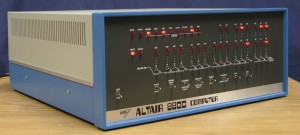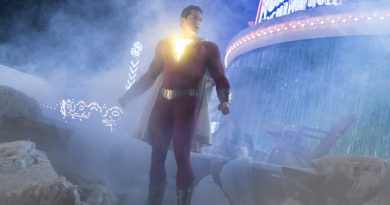Retro SciFi Reviews – SLEEPWALKER’S WORLD by Gordon R. Dickson
 Sleepwalker’s World
Sleepwalker’s World
Gordon R. Dickson
DAW, 158 pages
First published in 1972
[su_dropcap style=”flat” size=”4″]O[/su_dropcap]nce again I need to talk a bit about why I picked it up before I talk about the book itself. I picked up this one along with the book from my last review (see Flux by Ron Goulart). This is another DAW book, number 28 to be exact. If you’re not familiar with the original DAW, each book was numbered in chronological order so this is the twenty-eighth book that was printed and that occurred some time in 1972. The cover claims that this was the only SciFi novel chosen by The New York Times as one of their “Hundred Best Books of the Year” but, even with the internet I have not been able to verify that. I’ve personally read several Science Fiction novels from 1972 and I really can’t say which one was the best. I guess I’ll have to go by the old adage “They couldn’t print it if it wasn’t true.”
The other reason that I picked up this book is the author. I am quite familiar with Gordon R. Dickson through my adventures in SciFi; notably his “Dorsai” series more commonly known as “The Childe Cycle.” This series of books is rather definitive of much of Gordon’s work. The Dorsai are a race of humans who are bred and trained to be the ultimate warriors; mercenaries for the other, more advanced worlds.
This book is set in a dystopian future where the world food supply is manufactured in huge plants powered by heat drawn from the Earth’s core via huge shafts drilled through the crust. The downside of these life saving plants is that, when they are running, the people are unable to stay awake. It’s rather mysterious as to why this is happening, but the obvious question: is this just a side effect or is it intentional? On top of that, is the plan to send men to explore the stars for a new home for humanity just a ruse to build false hope?
The hero of the story is one Rafe Harald. Rafe is what one might call a cosmonaut, based on the Moon working on “The Project.” The “Project” is an ambitious work intending to rescue mankind by opening up the avenues to the stars. The problem is that the “Project” has been stalled for several years due to technical difficulties with the cryogenics required to keep the cosmonauts alive on the extended journey. Rafe hijacks a shuttle to Earth to hunt down his old friend Ab, a biophysicist, who disappeared soon after Rafe recommended him for the project. True to Gordon’s style of writing, Rafe is a bit of a superhuman due to breeding and training so he is able to stay awake while the food plants are running mostly through mental focus.
In this novel there is some forward thinking science including:
- Powering production by pulling heat from the Earth’s core.
- A wolf that is able to speak due to a microcomputer implanted its brain and surgical enhancements to its throat and lips.
The power generation concept is interesting, but the use of geothermal energy has been around for many years. Personally I find the use of a microcomputer intriguing for a novel published in 1972. A bit of research reveals that the first microprocessor was introduced by Intel Inc. in 1971 – the 4004, a 4-bit processor of very limited power. The Intel 8080 8-bit microprocessor wasn’t introduced until 1974 and the first PC, the Altair 8800 based on the 8080 processor, came out in 1975. It’s pretty obvious that the Altair 8800 was far too large to be implanted into even the largest of dogs and I’m not sure where the power supply would plug in.
I can only assume that Gordon judiciously applied Moore’s law to arrive at this possibility. For the uninitiated, “Moore’s Law” is a reference to the 1965 prediction by Gordon Moore, the co-founder of Intel, that the density of transistors per square inch in computer chips would double very year. This prediction held true for quite some time and recently has only slowed to a doubling every 18 months or two years. In the days of the 4004, transistor densities were counted by the thousands (around 2), 44 years later it’s by the billions.
Now that we count transistors by the billions we are close to getting that computer enhanced talking dog. I read articles quite often these days expounding the advancements in related areas but one should really consider the ethical issues involved in such an undertaking. You might think it’s cool to have a talking dog but you might be surprised at what the dog says about it.





